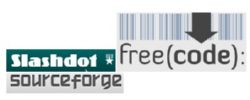Site Development
Slashdot started in
1997 as
Chips and Dips by Rob “CmdrTaco” Malda. He posted links to news articles that interested him, mostly on open-source software and tech news. Between working as an ad programmer and going to college, he ran it off of a single server. In October of 1997, he registered it (with a financial backing from Jeff “Hemos” Bates) as Slashdot.org. It exploded in 1998. After adding
new servers, Slashdot added Web forms for story submissions, as opposed to sending them directly to Malda’s email. In March of that year, Malda rewrote the old website, introducing the
“New Slashdot” on the 28th. Slashdot introduced user accounts in the summer of 1998.
“Ask Slashdot” debuted on May 13 of that year, with a question on potential ways to convince hardware manufacturers to be more compatible with Linux. In 1999,
moderation broadened from 25 editors to a rotating pool of 400 users. It was followed by
metamoderation in September, which let the older user accounts on the site rate moderations as fair or unfair. Slashdot introduced a
subscription service in March of 2002. For every 1,000 pages, $5 bought users a no-ad experience. In 2003, subscribers were allowed to view articles
10-20 minutes before they were published. For April Fool’s Day 2006, Malda announced that Slashdot didn’t have enough
female readers. Accompanying this announcement was a hot pink layout that replaced the familiar “News for Nerds. Stuff that matters.” with
“OMG!!! Ponies!!!” It lasted for only a day, but the comments ranged from “
This. Is. Sooo awesome! You guys are
totally invited to my sleepover.” to “April Fools. Haha.
Now PUT IT BACK. My eyes are bleeding already.” For another April Fool’s Day in 2009, Slashdot introduced
User Achievements.There were a few joke ones, but the feature does actually exist. In June of 2006,
Alex Bendiken won their Slashdot CSS Redesign Contest, prompting Slashdot’s first permanent layout change since 1998. The second site redesign happened in
January of 2011. On August 25, 2011,
Malda dropped a bomb on the community by announcing his resignation from Slashdot. He had posted more than 15,000 stories to Slashdot in his 14-year tenure. “For me,” he wrote in his final post, “the Slashdot of today is fused to the Slashdot of the past. This makes it really hard to objectively consider the future of the site.” He did not list any plans for the future, but in
March of 2012, he found a new home as Chief Strategist and Editor-at-Large for WaPo Labs at the Washington Post. Slashdot
launched SlashdotTV on March 28, 2012. The videos are filmed by the Slashdot crew and posted exclusively to the site.

Corporate
To support its growing readership (and time-consuming nature), Slashdot went into business. In 1998, the editors formed
Blockstackers to become the “corporate shell” for Slashdot, said Malda. The site began selling advertisements. The first few, with Herman Miller and Penguin Mints, were barter ads that resulted in furniture and caffeinated mints for the crew, according to Slashdot editor, Rob Rozeboom. On June 29, 1999, Slashdot was sold to
Andover.net, with the stipulation that creative control remained with the Slashdot editors. Malda reported it was the best way they could think of to support operating costs. And Andover.net was happy to let them keep on doing what they were doing. Andover.net embarked on a path riddled with name changes. In February of 2000, it merged with
VALinux. Slashdot became a part of their subgroup, Open Source Development Network (OSDN), said Timothy “timothy” Lord. VA Linux became
VASoftware in December 2001, which changed in 2007 to
SourceForge, Inc, which changed yet again to
Geeknet Inc in 2009. In 2004, the OSDN renamed itself the
Open Source Technology Group (OSTG).
Slashdot and the News
Slashdot is well-known for its users. They might not be the first to break the news, but they are the first to go at it--fact checking, discussing, and debating. Sometimes, though, they make the news. On October 4, 1999,
Johan Ingles, the deputy editor of
Jane’s Intelligence Review, reached out to Slashdot concerning an article on cyber terrorism he had received. He wanted readers to go over the piece and answer some questions. After compiling the comments, Ingles
decided he could not run the original article. Instead, he wrote a new one based on
interviews with the Slashdot community. In early March of 2001, an anonymous user posted a comment that contained the whole text of OT III, which was copyright material of the
Church of Scientology. The church contacted the editors, threatening legal action if the content was not removed. Slashdot conceded, at the advice of their lawyers, but posted links to the copyrighted material that was located in other places on the web.
Milestones
The oldest article in Slashdot’s archives, “
Become 007 on The Internet” from 1997, is not its first one. Rob “samzenpus” Rozeboom estimated about 1,000 earlier articles were lost in a database migration. In April 2001, Slashdot Japan launched, publishing its
first article on the 5th of that month. Slashdot’s
10,000th article was published on February 24, 2000 and the
100,000 article article was published on December 11, 2009. On November 3, 2004, Slashdot published the article “
Kerry Concedes Election to Bush.” The article generated more than 5,600 comments, making it the most discussed article in Slashdot history. This August, Slashdot’s
most visited article, “
ISP Owner Who Fought FBI Spying Freed From Gag Order,” was posted, which has generated more than 1.2 million hits.
Featured Interviews
In July 1999, a flipside of ‘Ask Slashdot’ was introduced where users could pose questions for a guest, and the highest-rated questions were answered.
Bruce Perens, a big name in the Linux/Open Source Movement, was their first interview. Slashdot Interviews are conducted regularly. Some star interviewees include:
Bruce Sterling, the sci-fi author who helped shape the
cyberpunk genre,
William Shatner,
Neil Gaiman,
Jimmy Wales, the founder of Wikipedia, and
Neal Stephenson, author.
Onward!
So where does Slashdot go from 15? “This year we've branched out more with some video coverage of the same kinds of topics we've been into for a long time... and a bit of liveblogging, which I suspect we'll see more of,” said Lord. “But a lot of Slashdot is about the user experience, and I think that the future holds a lot of improvement in that aspect of the site.”


